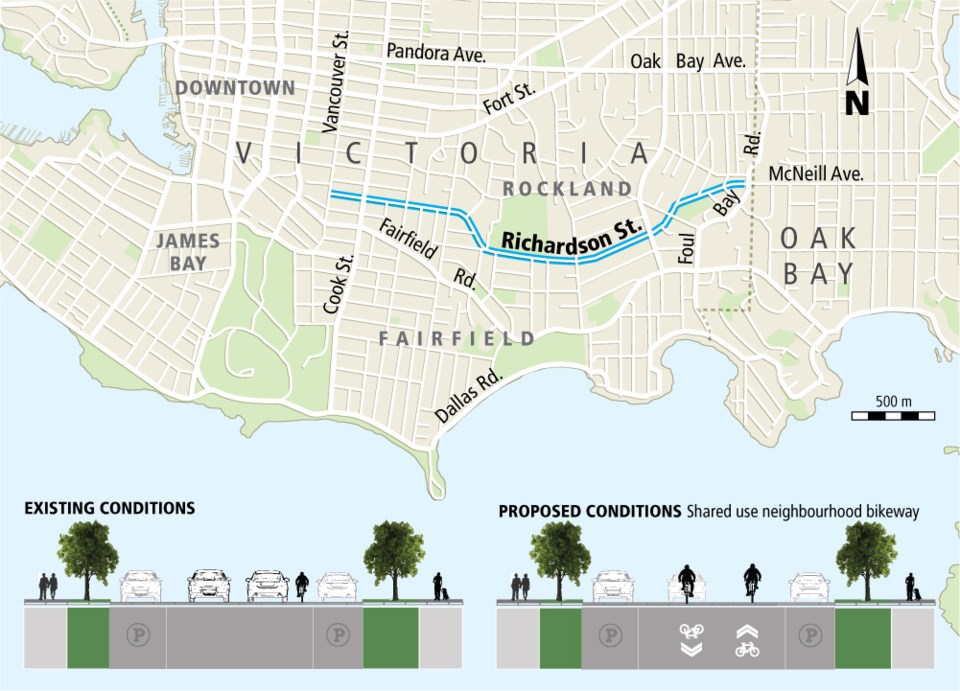Victoria’s plans to redesign Richardson Street will include space for two lanes of traffic shared by drivers and cyclists, while reducing traffic speeds and volumes by diverting cars to nearby streets.
Cyclists and drivers in each direction will share a lane of traffic, with on-street parking on both sides of the road, including about 70 additional parking spaces. Drivers wanting to pass a cyclist can pull around on the cyclist’s left, as they would on any local street.
The street’s redesign is part of the city’s plan to create a cycling network suitable for all ages and abilities so that an eight-year-old or an 80-year-old or anyone with little cycling experience feels safe and comfortable riding.
Corey Burger, policy and infrastructure chair of the Greater Victoria Cycling Coalition, said the design opens the road to cyclists who might not be comfortable riding there at the moment.
“There’s really good evidence, including in Victoria, that about half the population want to ride more than they already do. And the biggest reasons they don’t are lack of connected bikeway networks and fear of motor vehicle traffic,” Burger said. “So, it may not be for the person who’s already riding, but it’s definitely for the person who wants to ride and isn’t riding yet or isn’t riding on those streets.”
A 2019 survey by Cities, Health & Active Transportation Research suggests more than one-third of Victoria residents are interested in cycling but have concerns, and the top factors influencing the decision to ride are connected bike routes and a fear of traffic.
The research project, which received input from 1,000 respondents in Greater Victoria, with the majority living or working in Victoria, seeks to understand the impacts on health and transportation patterns when local governments make large investments in cycling infrastructure.
Richardson Street will not resemble Humboldt Street’s new design — what’s known as an advisory bike lane — where two-way vehicle traffic shares a single lane with a bike lane on each side.
Many who have expressed opposition to the Richardson Street plans have done so based on a misunderstanding that the approved design would have a single lane for two-way traffic.
The city initially considered an advisory bike lane on Richardson Street, but the idea was met with concern from both drivers and the cycling coalition.
The city also considered creating protected bike lanes, like the design on Fort and Pandora streets.
The initial phase of public engagement showed strong support for protected bike lanes, according to a staff report that went to council on July 2, but the community did not support the design because it would have meant a loss of parking, affect driveway access along the corridor and provide limited benefits to pedestrians.
The current design, which council approved on July 2, includes five traffic diversions along the 2.8-kilometre route that links the downtown core to the Fairfield-Gonzales neighbourhood, Rockland and the District of Oak Bay.
The traffic diversions are intended to reduce vehicle volumes from the roughly 2,800 to 3,800 trips per day on Richardson Street to 500 to 1,000 trips per day.
Reducing traffic volumes and lowering speed limits to 30 km/h are key components in creating shared-use bikeways that are appropriate for all ages and abilities.
Concerns have been raised that diverting traffic from Richardson Street will snarl traffic on adjacent roads.
The city report says locations for the five traffic diversions — at Cook Street, Lotbiniere Avenue, St. Charles Street, Maddison Street and Foul Bay Road — are designed to avoid redirecting all traffic onto any one street.
“Changes will require some people to alter their typical driving habits to get to and from local destinations or for commuting purposes, but interventions won’t result in all traffic being directed to one route,” says the staff report by acting director of engineering and public works Philip Bellefontaine.
About 40 to 60 per cent of traffic during peak periods on Richardson is a result of drivers choosing to use the street as a cut-through instead of adjacent collector and arterial roads.
The city’s design will redirect the majority of these through-trips to Fairfield Road, Richmond Road, Oak Bay Avenue, and Fort Street. The staff report says the change may add four to seven minutes in travel time for a someone driving from Oak Bay to downtown.
Shelly Urquhart, who drives regularly on Richardson, said she’s opposed to adding more bike lanes in the city and thinks the changes are unnecessary, because she doesn’t see many cyclists riding on the road when she drives it.
“There’s nothing wrong with it,” she said.
regan[email protected]



